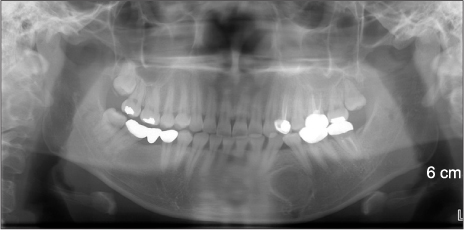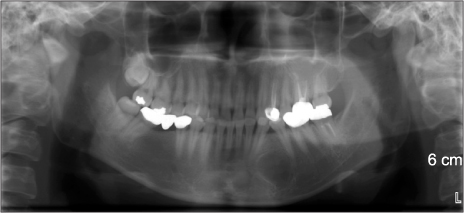J Korean Assoc Oral Maxillofac Surg.
2012 Jun;38(3):166-170. 10.5125/jkaoms.2012.38.3.166.
Calcifying epithelial odontogenic tumor associated with the left mandibular first premolar: a case report and literature review
- Affiliations
-
- 1Department of Oral and Maxillofacial Surgery, Daejeon Dental Hospital, School of Dentistry, Wonkwang University, Daejeon, Korea. omslee@daum.net
- 2Wonkwang Bone Regeneration Research Institute, Daejeon, Korea.
- KMID: 2043846
- DOI: http://doi.org/10.5125/jkaoms.2012.38.3.166
Abstract
- Calcifying epithelial odontogenic tumor (CEOT) is a rarely reported benign tumor, accounting for 0.4-3% of all odontogenic tumors. Approximately 150 cases have been reported in the literature between 1958 and 2003. The age range of CEOT varies from 8 to 92 years with mean of 36.9 years, and the occurrence of the lesion in both genders is almost equal. It has 2 clinico-topographic variants: the intraosseous (94%) and the extraosseous (6%) type. The intraosseous type has a predilection for mandible (maxilla : mandible ratio of 1 : 2). The intraosseous CEOT commonly associated with non-erupted teeth accounts for more than half (52%) of the cases and usually appears as painless swelling that causes bony expansion. The location of diffused round-shaped calcifying material is inside the connective tissue stroma and epithelial islands. The tumors tend to be located toward the tooth crown, which usually has a unilocular radiolucent region containing variant radiopaque materials radiologically. In this paper, we report a case of CEOT occurring in the left mandibular first premolar of a 23-year-old female and present a brief review of the literature.
MeSH Terms
Figure
Reference
-
1. Cheng YS, Wright JM, Walstad WR, Finn MD. Calcifying epithelial odontogenic tumor showing microscopic features of potential malignant behavior. Oral Surg Oral Med Oral Pathol Oral Radiol Endod. 2002. 93:287–295.
Article2. Rapidis AD, Stavrianos SD, Andressakis D, Lagogiannis G, Bertin PM. Calcifying epithelial odontogenic tumor (CEOT) of the mandible: clinical therapeutic conference. J Oral Maxillofac Surg. 2005. 63:1337–1347.
Article3. Philipsen HP, Reichart PA. Calcifying epithelial odontogenic tumour: biological profile based on 181 cases from the literature. Oral Oncol. 2000. 36:17–26.
Article4. Neville BW, Damm DD, Allen CM, Bouquot JE. Oral and maxillofacial pathology. 2002. 3rd ed. Philadelphia: W. B. Saunders.5. Deboni MC, Naclério-Homem Mda G, Pinto DS Junior, Traina AA, Cavalcanti MG. Clinical, radiological and histological features of calcifying epithelial odontogenic tumor: case report. Braz Dent J. 2006. 17:171–174.
Article6. Gon F. The calcifying epithelial odontogenic tumor: report of a case and a study of its histogenesis. Br J Cancer. 1965. 19:39–50.7. Takeda Y, Suzuki A, Sekiyama S. Peripheral calcifying epithelial odontogenic tumor. Oral Surg Oral Med Oral Pathol. 1983. 56:71–75.
Article8. Gopalakrishnan R, Simonton S, Rohrer MD, Koutlas IG. Cystic variant of calcifying epithelial odontogenic tumor. Oral Surg Oral Med Oral Pathol Oral Radiol Endod. 2006. 102:773–777.
Article9. Franklin CD, Pindborg JJ. The calcifying epithelial odontogenic tumor. A review and analysis of 113 cases. Oral Surg Oral Med Oral Pathol. 1976. 42:753–765.10. Anavi Y, Kaplan I, Citir M, Calderon S. Clear-cell variant of calcifying epithelial odontogenic tumor: clinical and radiographic characteristics. Oral Surg Oral Med Oral Pathol Oral Radiol Endod. 2003. 95:332–339.
Article11. Kumamoto H, Sato I, Tateno H, Yokoyama J, Takahashi T, Ooya K. Clear cell variant of calcifying epithelial odontogenic tumor (CEOT) in the maxilla: report of a case with immunohistochemical and ultrastructural investigations. J Oral Pathol Med. 1999. 28:187–191.12. Schmidt-Westhausen A, Philipsen HP, Reichart PA. Clear cell calcifying epithelial odontogenic tumor. A case report. Int J Oral Maxillofac Surg. 1992. 21:47–49.13. Sapp JP, Eversole LR, Wysocki GP. Contemporary oral and maxillofacial pathology. 2004. 2nd ed. New York: Elsevier.14. Damm DD, White DK, Drummond JF, Poindexter JB, Henry BB. Combined epithelial odontogenic tumor: adenomatoid odontogenic tumor and calcifying epithelial odontogenic tumor. Oral Surg Oral Med Oral Pathol. 1983. 55:487–496.
Article
- Full Text Links
- Actions
-
Cited
- CITED
-
- Close
- Share
- Similar articles
-
- The Calcifying Epithelial Odonogenic Tumor: Report of a Case
- Odontogenic ghost cell carcinoma arising from odontogenic epithelial tumor in maxilla: A case report
- Dentinogenic Ghost Cell Tumor: A Case Report and Review of Literature
- Current Concepts and Occurrence of Epithelial Odontogenic Tumors: II. Calcifying Epithelial Odontogenic Tumor Versus Ghost Cell Odontogenic Tumors Derived from Calcifying Odontogenic Cyst
- Calcifying epithelial odontogenic tumor (CEOT) in palate: report of a case






